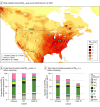Association of Particulate Matter Exposure With Lung Function and Mortality Among Patients With Fibrotic Interstitial Lung Disease
- PMID: 36251286
- PMCID: PMC9577882
- DOI: 10.1001/jamainternmed.2022.4696
Association of Particulate Matter Exposure With Lung Function and Mortality Among Patients With Fibrotic Interstitial Lung Disease
Erratum in
-
Error in Figure 2.JAMA Intern Med. 2022 Dec 1;182(12):1331. doi: 10.1001/jamainternmed.2022.5683. JAMA Intern Med. 2022. PMID: 36469031 Free PMC article. No abstract available.
Abstract
Importance: Particulate matter 2.5 μm or less in diameter (PM2.5) is associated with adverse outcomes for patients with idiopathic pulmonary fibrosis, but its association with other fibrotic interstitial lung diseases (fILDs) and the association of PM2.5 composition with adverse outcomes remain unclear.
Objective: To investigate the association of PM2.5 exposure with mortality and lung function among patients with fILD.
Design, setting, and participants: In this multicenter, international, prospective cohort study, patients were enrolled in the Simmons Center for Interstitial Lung Disease Registry at the University of Pittsburgh in Pittsburgh, Pennsylvania; 42 sites of the Pulmonary Fibrosis Foundation Registry; and 8 sites of the Canadian Registry for Pulmonary Fibrosis. A total of 6683 patients with fILD were included (Simmons, 1424; Pulmonary Fibrosis Foundation, 1870; and Canadian Registry for Pulmonary Fibrosis, 3389). Data were analyzed from June 1, 2021, to August 2, 2022.
Exposures: Exposure to PM2.5 and its constituents was estimated with hybrid models, combining satellite-derived aerosol optical depth with chemical transport models and ground-based PM2.5 measurements.
Main outcomes and measures: Multivariable linear regression was used to test associations of exposures 5 years before enrollment with baseline forced vital capacity and diffusion capacity for carbon monoxide. Multivariable Cox models were used to test associations of exposure in the 5 years before censoring with mortality, and linear mixed models were used to test associations of exposure with a decrease in lung function. Multiconstituent analyses were performed with quantile-based g-computation. Cohort effect estimates were meta-analyzed. Models were adjusted for age, sex, smoking history, race, a socioeconomic variable, and site (only for Pulmonary Fibrosis Foundation and Canadian Registry for Pulmonary Fibrosis cohorts).
Results: Median follow-up across the 3 cohorts was 2.9 years (IQR, 1.5-4.5 years), with death for 28% of patients and lung transplant for 10% of patients. Of the 6683 patients in the cohort, 3653 were men (55%), 205 were Black (3.1%), and 5609 were White (84.0%). Median (IQR) age at enrollment across all cohorts was 66 (58-73) years. A PM2.5 exposure of 8 μg/m3 or more was associated with a hazard ratio for mortality of 4.40 (95% CI, 3.51-5.51) in the Simmons cohort, 1.71 (95% CI, 1.32-2.21) in the Pulmonary Fibrosis Foundation cohort, and 1.45 (95% CI, 1.18-1.79) in the Canadian Registry for Pulmonary Fibrosis cohort. Increasing exposure to sulfate, nitrate, and ammonium PM2.5 constituents was associated with increased mortality across all cohorts, and multiconstituent models demonstrated that these constituents tended to be associated with the most adverse outcomes with regard to mortality and baseline lung function. Meta-analyses revealed consistent associations of exposure to sulfate and ammonium with mortality and with the rate of decrease in forced vital capacity and diffusion capacity of carbon monoxide and an association of increasing levels of PM2.5 multiconstituent mixture with all outcomes.
Conclusions and relevance: This cohort study found that exposure to PM2.5 was associated with baseline severity, disease progression, and mortality among patients with fILD and that sulfate, ammonium, and nitrate constituents were associated with the most harm, highlighting the need for reductions in human-derived sources of pollution.
Conflict of interest statement
Figures



Retracted and republished from
-
Notice of Retraction and Replacement. Goobie et al. Association of Particulate Matter Exposure With Lung Function and Mortality Among Patients With Fibrotic Interstitial Lung Disease. JAMA Intern Med. 2022;182(12):1248-1259.JAMA Intern Med. 2023 Sep 1;183(9):1036-1038. doi: 10.1001/jamainternmed.2023.3110. JAMA Intern Med. 2023. Retracted and republished in: JAMA Intern Med. 2022 Dec 1;182(12):1248-1259. doi: 10.1001/jamainternmed.2022.4696. PMID: 37486643 Retracted and republished. No abstract available.
References
-
- Raghu G, Remy-Jardin M, Myers JL, et al. ; American Thoracic Society, European Respiratory Society, Japanese Respiratory Society, and Latin American Thoracic Society . Diagnosis of idiopathic pulmonary fibrosis: an official ATS/ERS/JRS/ALAT clinical practice guideline. Am J Respir Crit Care Med. 2018;198(5):e44-e68. doi:10.1164/rccm.201807-1255ST - DOI - PubMed
Publication types
MeSH terms
Substances
LinkOut - more resources
Full Text Sources
Medical

